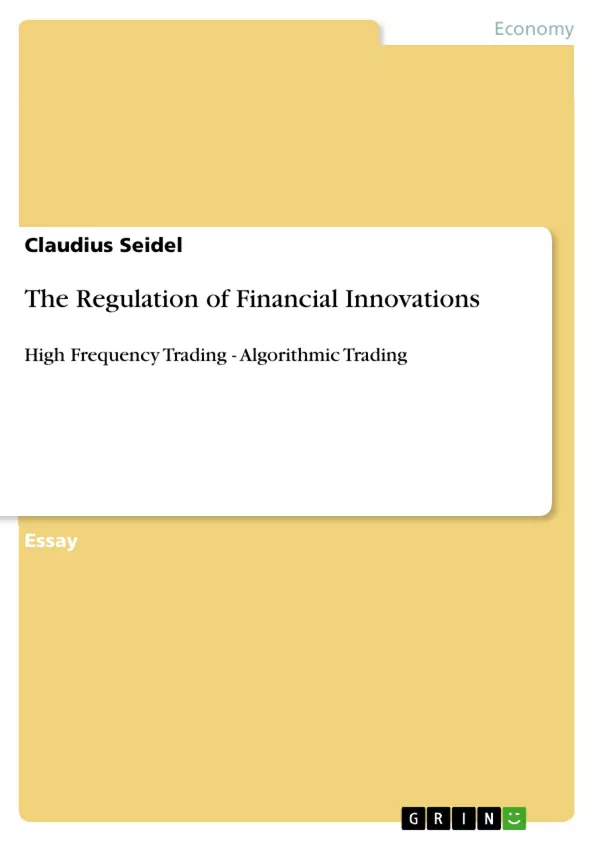The paper deals with attempts to regulate innovations in the financial sector. This is demonstrated by the issue of High Frequency Trading/Algorithmic Trading. Possible consequences for stock markets and economic systems are taken into account and discussed.
Inhaltsverzeichnis (Table of Contents)
- 1. Introduction
- 2.1. Definition of financial innovation
- 2.2. Regulation in the financial sector
- 3.1. Financial innovations: High Frequency Trading and Algorithmic Trading
- 3.2. Positive and negative effects of AT/HFT
- 4. Regulation attempts on High Frequency Trading and Algorithmic Trading
- 5. Conclusion
Zielsetzung und Themenschwerpunkte (Objectives and Key Themes)
This essay aims to provide a comprehensive analysis of financial innovations, particularly focusing on High Frequency Trading (HFT), a recent development in algorithmic trading. It examines the context of regulatory regimes and efforts in relation to HFT, highlighting its potential benefits and drawbacks.
- Definition and nature of financial innovation
- Role and impact of regulatory frameworks in the financial sector
- Characteristics and implications of High Frequency Trading (HFT)
- Positive and negative effects of HFT on financial markets
- Regulatory attempts and challenges in managing HFT activities
Zusammenfassung der Kapitel (Chapter Summaries)
- Chapter 1: Introduction: This chapter introduces the topic of financial market regulations, highlighting the public debate triggered by the recent global financial crisis. It then focuses on the essay's objective to explore financial innovations through the lens of High Frequency Trading (HFT) and its regulatory implications.
- Chapter 2.1: Definition of financial innovation: This section defines the concept of innovation, drawing on existing definitions and applying it to the context of financial markets. It differentiates between product and process innovations, emphasizing the emergence of financial innovations as a response to constraints and exposures within the system.
- Chapter 2.2: Regulation in the financial sector: This section delves into the complexities of regulating the financial sector, highlighting the roles of national authorities and the difficulty in defining a singular regulatory regime. It focuses on the specific case of Germany and its regulatory body, the BaFin, emphasizing the importance of transparency in stock markets.
- Chapter 3.1: Financial innovations: High Frequency Trading and Algorithmic Trading: This chapter introduces High Frequency Trading (HFT) as a specific example of financial innovation, emphasizing its evolution from algorithmic trading. It explores the origins of HFT and its connection to advancements in information and communication technologies (ICT).
- Chapter 3.2: Positive and negative effects of AT/HFT: This section examines the potential benefits and drawbacks of HFT. It highlights the potential contributions of HFT to market efficiency and liquidity, while also addressing concerns about potential market instability and limited social benefits.
Schlüsselwörter (Keywords)
The essay revolves around the key concepts of financial innovation, High Frequency Trading (HFT), algorithmic trading, regulatory frameworks, market efficiency, liquidity, market stability, and the potential for instability caused by financial innovations.
- Arbeit zitieren
- Claudius Seidel (Autor:in), 2011, The Regulation of Financial Innovations, München, GRIN Verlag, https://www.grin.com/document/181249



